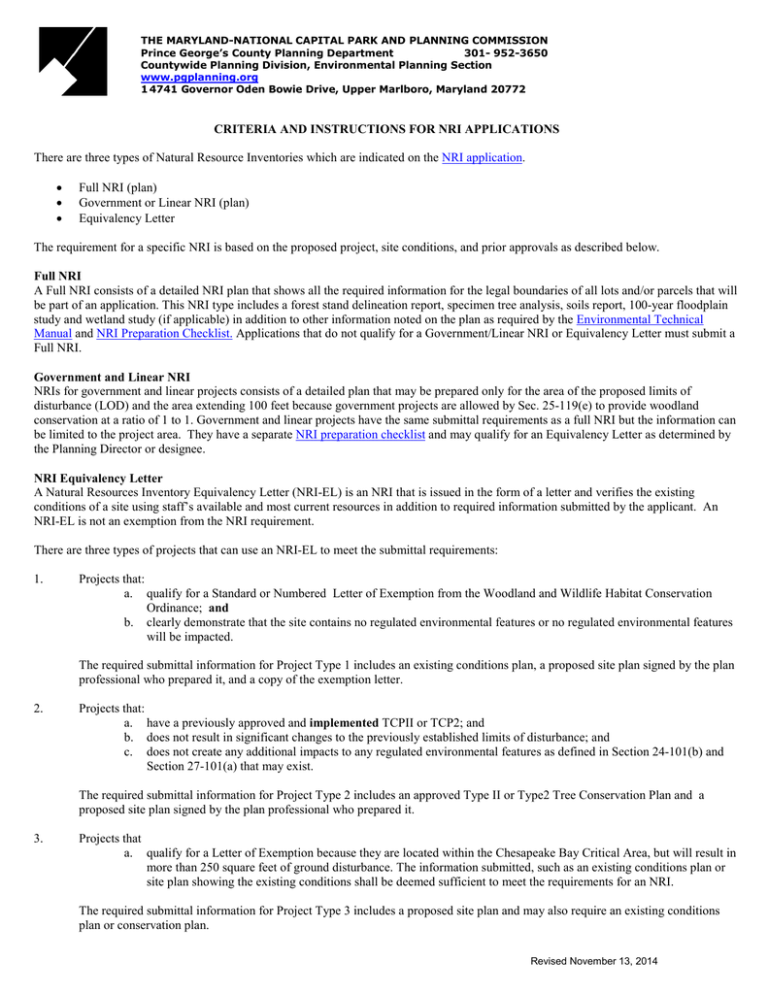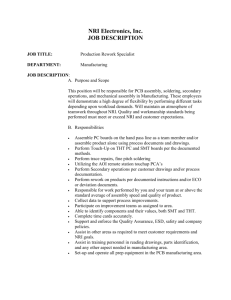CRITERIA AND INSTRUCTIONS FOR NRI APPLICATIONS There
advertisement

THE MARYLAND-NATIONAL CAPITAL PARK AND PLANNING COMMISSION Prince George’s County Planning Department 301- 952-3650 Countywide Planning Division, Environmental Planning Section www.pgplanning.org 1 4741 Governor Oden Bowie Drive, Upper Marlboro, Maryland 20772 CRITERIA AND INSTRUCTIONS FOR NRI APPLICATIONS There are three types of Natural Resource Inventories which are indicated on the NRI application. • • • Full NRI (plan) Government or Linear NRI (plan) Equivalency Letter The requirement for a specific NRI is based on the proposed project, site conditions, and prior approvals as described below. Full NRI A Full NRI consists of a detailed NRI plan that shows all the required information for the legal boundaries of all lots and/or parcels that will be part of an application. This NRI type includes a forest stand delineation report, specimen tree analysis, soils report, 100-year floodplain study and wetland study (if applicable) in addition to other information noted on the plan as required by the Environmental Technical Manual and NRI Preparation Checklist. Applications that do not qualify for a Government/Linear NRI or Equivalency Letter must submit a Full NRI. Government and Linear NRI NRIs for government and linear projects consists of a detailed plan that may be prepared only for the area of the proposed limits of disturbance (LOD) and the area extending 100 feet because government projects are allowed by Sec. 25-119(e) to provide woodland conservation at a ratio of 1 to 1. Government and linear projects have the same submittal requirements as a full NRI but the information can be limited to the project area. They have a separate NRI preparation checklist and may qualify for an Equivalency Letter as determined by the Planning Director or designee. NRI Equivalency Letter A Natural Resources Inventory Equivalency Letter (NRI-EL) is an NRI that is issued in the form of a letter and verifies the existing conditions of a site using staff’s available and most current resources in addition to required information submitted by the applicant. An NRI-EL is not an exemption from the NRI requirement. There are three types of projects that can use an NRI-EL to meet the submittal requirements: 1. Projects that: a. qualify for a Standard or Numbered Letter of Exemption from the Woodland and Wildlife Habitat Conservation Ordinance; and b. clearly demonstrate that the site contains no regulated environmental features or no regulated environmental features will be impacted. The required submittal information for Project Type 1 includes an existing conditions plan, a proposed site plan signed by the plan professional who prepared it, and a copy of the exemption letter. 2. Projects that: a. have a previously approved and implemented TCPII or TCP2; and b. does not result in significant changes to the previously established limits of disturbance; and c. does not create any additional impacts to any regulated environmental features as defined in Section 24-101(b) and Section 27-101(a) that may exist. The required submittal information for Project Type 2 includes an approved Type II or Type2 Tree Conservation Plan and a proposed site plan signed by the plan professional who prepared it. 3. Projects that a. qualify for a Letter of Exemption because they are located within the Chesapeake Bay Critical Area, but will result in more than 250 square feet of ground disturbance. The information submitted, such as an existing conditions plan or site plan showing the existing conditions shall be deemed sufficient to meet the requirements for an NRI. The required submittal information for Project Type 3 includes a proposed site plan and may also require an existing conditions plan or conservation plan. Revised November 13, 2014



